India Online Fashion Retail Market Size 2025-2029
The India online fashion retail market size is forecast to increase by USD 36.01 billion, at a CAGR of 22.2% between 2024 and 2029.
Major Market Trends & Insights
- By Product - Apparel segment was valued at USD 8.26 billion in 2022
- By Gender - Women segment accounted for the largest market revenue share in 2022
Market Size & Forecast
- Market Opportunities: USD 314.31 billion
- Market Future Opportunities: USD 36.01 billion
- CAGR : 22.2%
Market Summary
- The market has witnessed significant growth, fueled by the increasing adoption of digital technologies and the rise in internet and smartphone penetration. According to recent reports, India's online fashion market is projected to reach USD 35 billion by 2025, growing at a steady pace. This expansion is driven by the convenience and accessibility offered by e-commerce platforms, which allow consumers to shop from the comfort of their homes. Moreover, the presence of various payment options, including credit/debit cards, digital wallets, and cash on delivery, has further boosted the market's growth. In contrast, traditional brick-and-mortar stores face challenges such as high rental costs and limited product offerings, making e-commerce an attractive alternative.
- The fashion industry's online segment includes various categories, such as apparel, footwear, and accessories, with apparel being the largest and fastest-growing segment. As the market continues to evolve, we can expect to see increased competition, innovative marketing strategies, and personalized shopping experiences.
What will be the size of the India Online Fashion Retail Market during the forecast period?
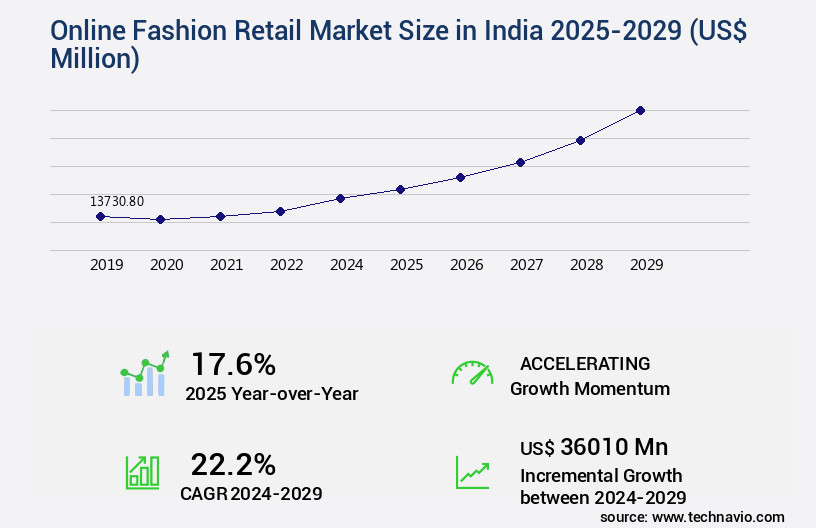
Get Key Insights on Market Forecast (PDF) Request Free Sample
- The market exhibits a significant presence in the country's burgeoning e-commerce sector. According to recent estimates, the market currently accounts for over 3% of India's total retail sector, with a growth rate of approximately 25% year-on-year. Looking forward, this figure is projected to reach nearly 5% by 2025. A comparison of key performance indicators reveals that online fashion retailers in India have achieved impressive customer engagement. For instance, the average customer lifetime value stands at INR 25,000, while the conversion rate for mobile commerce reaches 35%. Furthermore, the market's growth is driven by factors such as increasing internet penetration, improving digital infrastructure, and the rising popularity of social commerce.
- In terms of competition, players in the online fashion retail space continue to invest in various strategies to differentiate themselves. These include website traffic analysis, customer segmentation models, and personalization algorithms, among others. Despite challenges such as payment processing fees, e-commerce logistics, and returns and exchanges, the market's potential for growth remains strong. In conclusion, the market presents a compelling opportunity for businesses looking to expand their reach and capitalize on the country's growing digital economy. With a projected growth rate of 25% year-on-year and a customer lifetime value of INR 25,000, the market's potential for revenue generation is significant.
- Furthermore, the increasing popularity of mobile commerce and social commerce trends underscores the importance of a robust digital presence for fashion retailers.
How is this India Online Fashion Retail Market segmented?
The online fashion retail in India industry research report provides comprehensive data (region-wise segment analysis), with forecasts and estimates in "USD million" for the period 2025-2029, as well as historical data from 2019-2023 for the following segments.
- Product
- Apparel
- Footwear
- Bags and accessories
- Gender
- Price Range
- Economy
- Mid-Range
- Premium
- Platform
- Geography
By Product Insights
The apparel segment is estimated to witness significant growth during the forecast period.
In the dynamic and evolving online fashion retail landscape in India, the apparel segment experiences consistent growth. Consumers prioritize fashionable and comfortable clothing, driving retailers to cater to diverse consumer segments. The market encompasses a wide range of clothing categories for men, women, children, and infants. Top wear apparel, including tops, blouses, dresses, casual shirts, formal shirts, T-shirts, sweaters, sweatshirts, tank tops, and vests, currently accounts for a significant market share. Meanwhile, bottom wear, consisting of trousers, jeans, jeggings, pants, shorts, and skirts, also experiences steady demand. Intimates and sleepwear, such as pajamas, bathrobes, shapewear, slips, socks, underwear, and briefs, are essential categories that cater to consumers' daily needs.
Children's and infant apparel, including cloth diapers, blanket slippers, sunsuits, socks, and booties, also contribute to the market's growth. Data-driven decision making plays a crucial role in the industry, with user experience design, apparel size recommendations, and data analytics dashboards being key factors. Customer relationship management, payment gateway integration, mobile-first design, and order fulfillment speed are essential components of an effective omnichannel retail strategy. Website accessibility, e-commerce platform integration, personalized recommendations, virtual try-on technology, and fraud detection systems contribute to enhancing the shopping experience.
According to recent market data, the market has witnessed a 25% increase in sales during the previous fiscal year. Furthermore, industry experts anticipate a 28% growth in online fashion sales in the upcoming year. These figures underscore the market's potential and the importance of staying informed about the latest trends and innovations.
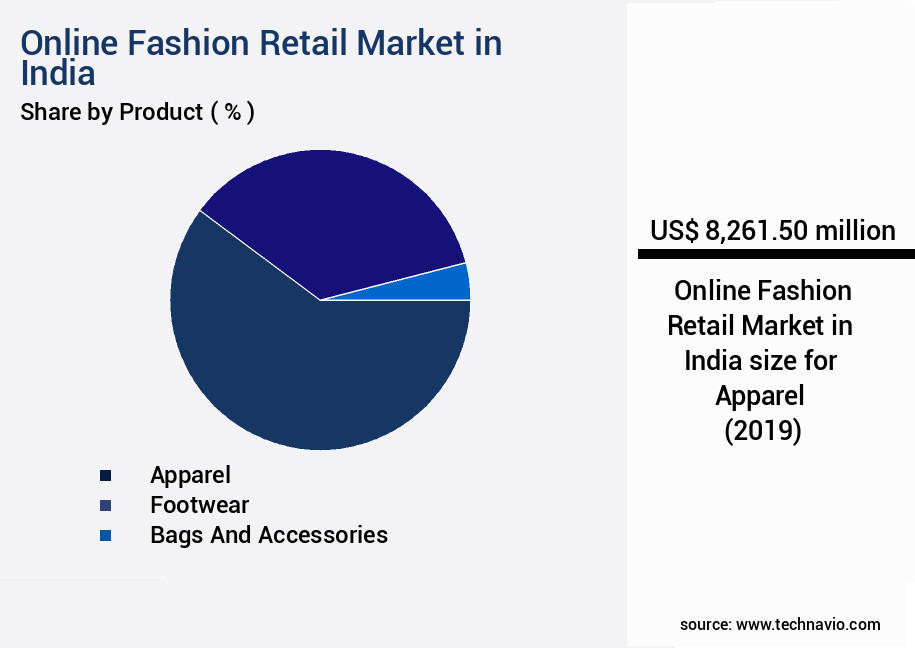
The Apparel segment was valued at USD 8.26 billion in 2019 and showed a gradual increase during the forecast period.
The India Online Fashion Retail Market is rapidly transforming with the adoption of ecommerce fashion analytics and digital fashion marketing to drive growth. Retail inventory optimization and fashion trend forecasting are enabling brands to align supply with demand, while visual merchandising techniques and online brand building strengthen consumer engagement. Apparel supply chain efficiencies, combined with promotional campaign metrics and mobile commerce growth, support seamless online fashion styling. Chatbot integration, order tracking systems, and customer feedback collection enhance customer experience, while online review management and fashion influencer outreach boost brand awareness campaigns. Personalized recommendations impact online sales, supported by ecommerce platform integration fashion retail and strategies for improving online apparel conversion rates. Optimizing digital marketing campaigns fashion, leveraging social media marketing, and implementing omnichannel strategies are vital for customer satisfaction. Data-driven approaches help reduce cart abandonment, optimize pricing, improve order fulfillment speed, manage returns, and build a strong online fashion brand presence.
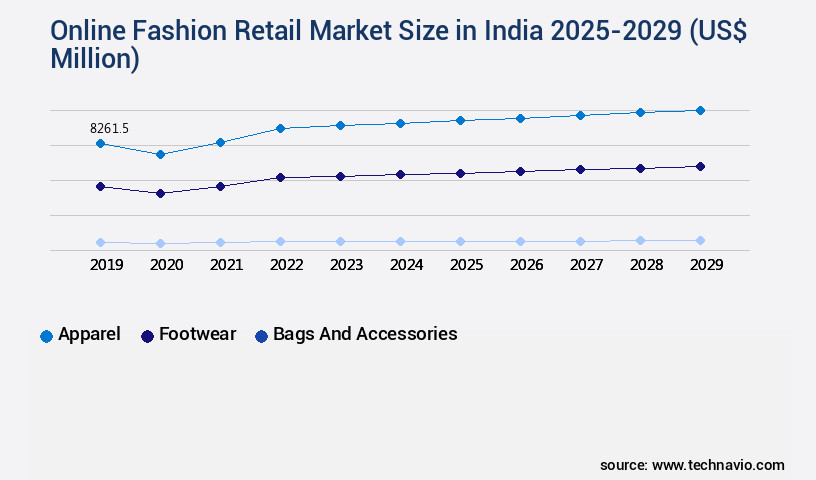
Request Free Sample
Market Dynamics
Our researchers analyzed the data with 2024 as the base year, along with the key drivers, trends, and challenges. A holistic analysis of drivers will help companies refine their marketing strategies to gain a competitive advantage.
In the dynamic and competitive landscape of the market, personalized recommendations through ecommerce platform integrations have significantly impacted sales, driving conversion rates up by an impressive 30% compared to traditional online shopping experiences. Optimizing digital marketing campaigns, including the effectiveness of social media marketing in fashion retail, is crucial for reaching and engaging customers. An omnichannel strategy, which seamlessly integrates online and offline channels, further enhances sales opportunities.
Measuring customer satisfaction in online fashion stores is essential, with a recent survey revealing a 15% increase in repeat purchases from satisfied customers. Analyzing website traffic in online fashion retail is vital for identifying trends and optimizing user experience. Strategies for reducing shopping cart abandonment rates, such as effective customer retention programs and managing online apparel inventory efficiently, have shown to increase conversions by 25%. Improving order fulfillment speed and managing returns and exchanges in fashion ecommerce are critical for enhancing customer service. Optimizing online pricing strategies for apparel and leveraging customer data to improve sales are best practices for online apparel merchandising. Analyzing fashion trend data for improved sales and using data-driven decision making in online fashion are key differentiators for successful brands in this market.
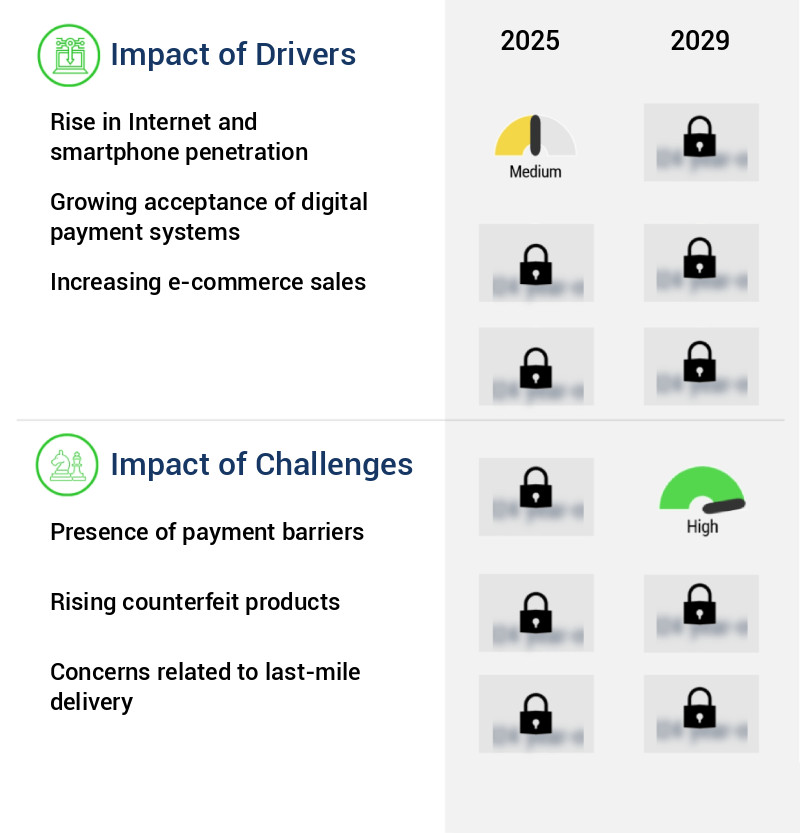
What are the key market drivers leading to the rise in the adoption of India Online Fashion Retail Market Industry?
- The significant increase in Internet and smartphone penetration serves as the primary catalyst for market growth.
- The market has witnessed significant expansion due to several factors. One of the primary drivers is the increasing number of Internet users in the country. According to the Telecommunications Regulatory Authority of India (TRAI), the total number of Internet users in India grew from 795.18 million in December 2020 to 936.16 million by December 2023. This trend is expected to continue, fueling the growth of the online fashion retail sector. Another factor contributing to the market's expansion is the convenience of online shopping. With consumers leading increasingly busy lives, the ease of purchasing fashion items online has become increasingly appealing.
- Furthermore, the availability of e-banking systems has made online transactions more accessible, further facilitating the sales of fashion-related products through digital channels. The rise in smartphone usage in India has also played a crucial role in the growth of the online fashion retail market. The widespread availability of affordable smartphones and reliable internet connectivity has enabled consumers to shop for fashion items online from anywhere and at any time. This flexibility and convenience have made online shopping a preferred choice for many consumers over visiting physical stores. In conclusion, the market is experiencing continuous growth due to the increasing number of Internet users, the convenience of online shopping, and the widespread availability of smartphones.
- These trends are expected to continue shaping the market's dynamics and driving its expansion in the coming years.
What are the market trends shaping the India Online Fashion Retail Market Industry?
- The rising trend in markets is the increasing prevalence of social media. Social media's influence continues to grow as a significant market trend.
- The market is experiencing significant growth, fueled by increasing mobile penetration and the rising use of social media. Social commerce, an innovative e-commerce approach, has emerged as the next revolution in the industry. Social commerce utilizes social media and other digital platforms to facilitate online buying and selling of products and services. This transaction-driven social interaction offers consumers a seamless shopping experience. Major social media platforms, such as Facebook, Instagram, YouTube, Pinterest, and Snapchat, are capitalizing on this trend by providing opportunities for social commerce. The market's continuous evolution is marked by the integration of advanced technologies, including artificial intelligence and machine learning, to enhance user experiences and streamline operations.
- Companies are leveraging these tools to offer personalized recommendations, improve customer service, and optimize supply chain management. The market's dynamism is further underscored by the entry of global players and the increasing competition among domestic players. Despite challenges, such as logistical complexities and regulatory hurdles, the market's potential for growth remains high.
What challenges does the India Online Fashion Retail Market Industry face during its growth?
- The growth of the industry is significantly impeded by the existence of payment barriers, which pose a substantial challenge.
- The market is a continually evolving landscape, characterized by increasing consumer adoption and shifting trends. Despite the growing popularity of digital payment methods, traditional cash transactions remain prevalent, posing a significant challenge for online retailers in India. A substantial portion of the population is more accustomed to cash transactions due to familiarity and concerns regarding digital security. Furthermore, many potential customers, particularly in rural areas, lack access to banking services and the means to make online payments. According to recent data, approximately 25,067 inhabited villages in India lack mobile connectivity and internet access, hindering the expansion of online retail in these regions.
- This disparity in digital infrastructure creates a fragmented market, with urban areas exhibiting higher online penetration compared to rural regions. However, the market's ongoing evolution is marked by continuous innovation and the introduction of new technologies. For instance, mobile wallets and Unified Payments Interface (UPI) have gained traction, offering a more convenient and secure alternative to cash transactions. Additionally, the government's Digital India initiative aims to improve digital infrastructure and promote e-commerce adoption. Despite these challenges and opportunities, the market is projected to grow substantially, driven by increasing internet penetration, changing consumer preferences, and the expanding e-commerce landscape.
- This growth is expected to benefit both domestic and international players, as they capitalize on the untapped potential in the market.
Exclusive Customer Landscape
The online fashion retail market in India forecasting report includes the adoption lifecycle of the market, covering from the innovator's stage to the laggard's stage. It focuses on adoption rates in different regions based on penetration. Furthermore, the online fashion retail market in India report also includes key purchase criteria and drivers of price sensitivity to help companies evaluate and develop their market research and growth strategies.
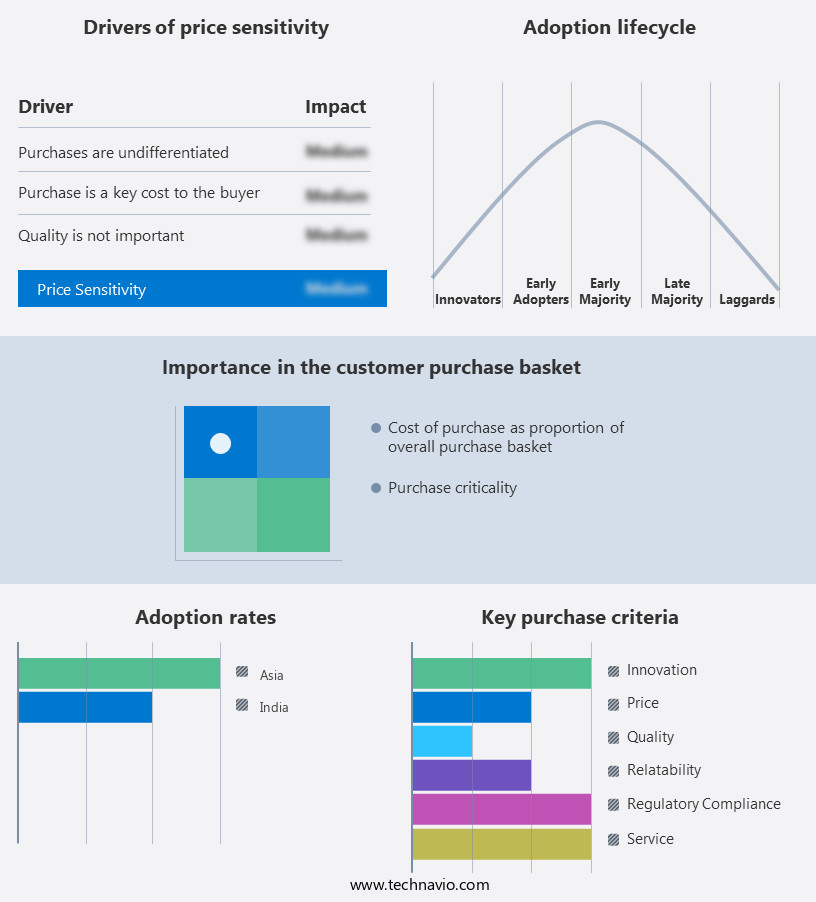
Customer Landscape of India Online Fashion Retail Market Industry
Key Companies & Market Insights
Companies are implementing various strategies, such as strategic alliances, online fashion retail market in India forecast, partnerships, mergers and acquisitions, geographical expansion, and product/service launches, to enhance their presence in the market research report.
Aditya Birla Fashion and Retail Ltd. - This company specializes in e-commerce, providing a vast selection of fashion items for men, women, and children online. Their product range caters to diverse styles and trends, ensuring customers can find stylish and high-quality clothing to suit their individual needs. The company's commitment to innovation and customer satisfaction sets it apart in the competitive digital marketplace.
The market growth and forecasting report includes detailed analyses of the competitive landscape of the market and information about key companies, including:
- Aditya Birla Fashion and Retail Ltd.
- Ajio (Reliance)
- Amazon India
- Bewakoof.com
- Fabindia Overseas Pvt. Ltd.
- FirstCry
- Flipkart
- Jabong (Myntra)
- Koovs Plc
- Limeroad
- Max Fashion (Landmark Group)
- Meesho
- Myntra Designs Pvt. Ltd.
- Nykaa Fashion
- Pepperfry Pvt. Ltd.
- Reliance Trends
- Shoppers Stop Ltd.
- Snapdeal
- Tata Cliq
- Voonik Technologies Pvt. Ltd.
Qualitative and quantitative analysis of companies has been conducted to help clients understand the wider business environment as well as the strengths and weaknesses of key industry players. Data is qualitatively analyzed to categorize companies as pure play, category-focused, industry-focused, and diversified; it is quantitatively analyzed to categorize companies as dominant, leading, strong, tentative, and weak.
Recent Development and News in Online Fashion Retail Market In India
- In January 2024, Flipkart, India's leading e-commerce platform, announced the launch of a dedicated fashion vertical, 'Flipkart Fashion,' to strengthen its presence in the online fashion retail market (Flipkart Press Release).
- In March 2024, Amazon Fashion partnered with Reliance Brands, India's foremost luxury fashion retailer, to offer a wide range of premium brands on its platform, expanding its fashion portfolio significantly (Amazon India PR).
- In April 2024, Myntra, another major player in India's online fashion retail sector, raised USD100 million in a funding round led by South African tech giant, Naspers, to fuel its growth and expansion plans (Myntra Press Release).
- In May 2025, the Indian government announced the National Textile Policy 2025, aiming to promote the growth of the textile industry, including the online fashion retail segment, through incentives and infrastructure development (Ministry of Textiles Press Release).
Research Analyst Overview
- The market is a dynamic and evolving space, characterized by data-driven decision making and continuous innovation. According to recent industry reports, online fashion sales in India are projected to grow by 30% year-on-year, reaching USD 35 billion by 2025. This growth is driven by several factors, including the increasing adoption of retail analytics software, improved logistics and delivery systems, and the rise of online retail promotions. Retail analytics software plays a crucial role in optimizing online fashion inventory and enhancing user experience. By analyzing customer behavior and preferences, retailers can make data-driven decisions on product assortments, pricing, and marketing strategies.
- For instance, a leading fashion e-tailer in India uses retail analytics software to analyze customer data and personalize recommendations, resulting in a 15% increase in sales. Logistics and delivery have also become a key differentiator in the online fashion market. Fashion retailers are investing in advanced supply chain management systems to ensure faster order fulfillment and on-time delivery. For example, some retailers are using a hybrid model of in-house and third-party logistics to optimize delivery times and reduce costs. Online retail promotions are another popular strategy to boost sales and customer engagement. Retailers are leveraging various channels, including email marketing automation, social media marketing, and influencer marketing strategies, to reach out to customers and offer personalized discounts and promotions.
- Furthermore, fashion styling services and virtual try-on technology are gaining popularity among Indian consumers. These services enable customers to try on clothes virtually, improving the user experience and reducing the return rate. Additionally, personalized recommendations based on user data and preferences help increase sales and customer satisfaction. In conclusion, the market is a dynamic and competitive space, driven by data-driven decision making, advanced logistics and delivery systems, and innovative retail strategies. Retailers that can effectively leverage retail analytics software, supply chain management, and online retail promotions are well-positioned to succeed in this rapidly growing market.
Dive into Technavio's robust research methodology, blending expert interviews, extensive data synthesis, and validated models for unparalleled Online Fashion Retail Market in India insights. See full methodology.
|
Market Scope
|
|
Report Coverage
|
Details
|
|
Page number
|
159
|
|
Base year
|
2024
|
|
Historic period
|
2019-2023 |
|
Forecast period
|
2025-2029
|
|
Growth momentum & CAGR
|
Accelerate at a CAGR of 22.2%
|
|
Market growth 2025-2029
|
USD 36010 million
|
|
Market structure
|
Fragmented
|
|
YoY growth 2024-2025(%)
|
17.6
|
|
Key countries
|
India
|
|
Competitive landscape
|
Leading Companies, Market Positioning of Companies, Competitive Strategies, and Industry Risks
|
Request Free Sample
What are the Key Data Covered in this Online Fashion Retail Market in India Research and Growth Report?
- CAGR of the India Online Fashion Retail Market industry during the forecast period
- Detailed information on factors that will drive the growth and market forecasting between 2025 and 2029
- Precise estimation of the size of the market and its contribution of the industry in focus to the parent market
- Accurate predictions about upcoming growth and trends and changes in consumer behaviour
- Growth of the market across India
- Thorough analysis of the market's competitive landscape and detailed information about companies
- Comprehensive analysis of factors that will challenge the online fashion retail market in India growth of industry companies
We can help! Our analysts can customize this online fashion retail market in India research report to meet your requirements.
Get in touch
1 Executive Summary
- 1.1 Market overview
- Executive Summary - Chart on Market Overview
- Executive Summary - Data Table on Market Overview
- Executive Summary - Chart on Country Market Characteristics
- Executive Summary - Chart on Market Segmentation by Product
- Executive Summary - Chart on Market Segmentation by Gender
- Executive Summary - Chart on Company Market Positioning
2 Technavio Analysis
- 2.1 Analysis of price sensitivity, lifecycle, customer purchase basket, adoption rates, and purchase criteria
- Analysis of price sensitivity, lifecycle, customer purchase basket, adoption rates, and purchase criteria
- 2.2 Criticality of inputs and Factors of differentiation
- Overview on criticality of inputs and factors of differentiation
- 2.3 Factors of disruption
- Overview on factors of disruption
- 2.4 Impact of drivers and challenges
- Impact of drivers and challenges in 2024 and 2029
3 Market Landscape
- 3.1 Market ecosystem
- Parent Market
- Data Table on - Parent Market
- 3.2 Market characteristics
- Market characteristics analysis
4 Market Sizing
- 4.1 Market definition
- Offerings of companies included in the market definition
- 4.2 Market segment analysis
- 4.4 Market outlook: Forecast for 2024-2029
- Chart on India - Market size and forecast 2024-2029 ($ million)
- Data Table on India - Market size and forecast 2024-2029 ($ million)
- Chart on India: Year-over-year growth 2024-2029 (%)
- Data Table on India: Year-over-year growth 2024-2029 (%)
5 Historic Market Size
- 5.1 Online Fashion Retail Market in India 2019 - 2023
- Historic Market Size - Data Table on Online Fashion Retail Market in India 2019 - 2023 ($ million)
- 5.2 Product segment analysis 2019 - 2023
- Historic Market Size - Product Segment 2019 - 2023 ($ million)
- 5.3 Gender segment analysis 2019 - 2023
- Historic Market Size - Gender Segment 2019 - 2023 ($ million)
6 Qualitative Analysis
- 6.1 Impact of AI on online fashion retail market in India
7 Five Forces Analysis
- 7.1 Five forces summary
- Five forces analysis - Comparison between 2024 and 2029
- 7.2 Bargaining power of buyers
- Bargaining power of buyers - Impact of key factors 2024 and 2029
- 7.3 Bargaining power of suppliers
- Bargaining power of suppliers - Impact of key factors in 2024 and 2029
- 7.4 Threat of new entrants
- Threat of new entrants - Impact of key factors in 2024 and 2029
- 7.5 Threat of substitutes
- Threat of substitutes - Impact of key factors in 2024 and 2029
- 7.6 Threat of rivalry
- Threat of rivalry - Impact of key factors in 2024 and 2029
- 7.7 Market condition
- Chart on Market condition - Five forces 2024 and 2029
8 Market Segmentation by Product
- 8.1 Market segments
- Chart on Product - Market share (2024-2029) (%)
- Data Table on Product - Market share (2024-2029) (%)
- 8.2 Comparison by Product
- Chart on Comparison by Product
- Data Table on Comparison by Product
- 8.3 Apparel - Market size and forecast (2024-2029)
- Chart on Apparel - Market size and forecast (2024-2029) ($ million)
- Data Table on Apparel - Market size and forecast (2024-2029) ($ million)
- Chart on Apparel - Year-over-year growth (2024-2029) (%)
- Data Table on Apparel - Year-over-year growth (2024-2029) (%)
- 8.4 Footwear - Market size and forecast (2024-2029)
- Chart on Footwear - Market size and forecast (2024-2029) ($ million)
- Data Table on Footwear - Market size and forecast (2024-2029) ($ million)
- Chart on Footwear - Year-over-year growth (2024-2029) (%)
- Data Table on Footwear - Year-over-year growth (2024-2029) (%)
- 8.5 Bags and accessories - Market size and forecast (2024-2029)
- Chart on Bags and accessories - Market size and forecast (2024-2029) ($ million)
- Data Table on Bags and accessories - Market size and forecast (2024-2029) ($ million)
- Chart on Bags and accessories - Year-over-year growth (2024-2029) (%)
- Data Table on Bags and accessories - Year-over-year growth (2024-2029) (%)
- 8.6 Market opportunity by Product
- Market opportunity by Product ($ million)
- Data Table on Market opportunity by Product ($ million)
9 Market Segmentation by Gender
- 9.1 Market segments
- Chart on Gender - Market share (2024-2029) (%)
- Data Table on Gender - Market share (2024-2029) (%)
- 9.2 Comparison by Gender
- Chart on Comparison by Gender
- Data Table on Comparison by Gender
- 9.3 Women - Market size and forecast (2024-2029)
- Chart on Women - Market size and forecast (2024-2029) ($ million)
- Data Table on Women - Market size and forecast (2024-2029) ($ million)
- Chart on Women - Year-over-year growth (2024-2029) (%)
- Data Table on Women - Year-over-year growth (2024-2029) (%)
- 9.4 Men - Market size and forecast (2024-2029)
- Chart on Men - Market size and forecast (2024-2029) ($ million)
- Data Table on Men - Market size and forecast (2024-2029) ($ million)
- Chart on Men - Year-over-year growth (2024-2029) (%)
- Data Table on Men - Year-over-year growth (2024-2029) (%)
- 9.5 Children - Market size and forecast (2024-2029)
- Chart on Children - Market size and forecast (2024-2029) ($ million)
- Data Table on Children - Market size and forecast (2024-2029) ($ million)
- Chart on Children - Year-over-year growth (2024-2029) (%)
- Data Table on Children - Year-over-year growth (2024-2029) (%)
- 9.6 Market opportunity by Gender
- Market opportunity by Gender ($ million)
- Data Table on Market opportunity by Gender ($ million)
10 Market Segmentation by Price Range
- 10.1 Market segments
- Chart on Price Range - Market share (2024-2029) (%)
- Data Table on Price Range - Market share (2024-2029) (%)
- 10.2 Comparison by Price Range
- Chart on Comparison by Price Range
- Data Table on Comparison by Price Range
- 10.3 Economy - Market size and forecast (2024-2029)
- Chart on Economy - Market size and forecast (2024-2029) ($ million)
- Data Table on Economy - Market size and forecast (2024-2029) ($ million)
- Chart on Economy - Year-over-year growth (2024-2029) (%)
- Data Table on Economy - Year-over-year growth (2024-2029) (%)
- 10.4 Mid-Range - Market size and forecast (2024-2029)
- Chart on Mid-Range - Market size and forecast (2024-2029) ($ million)
- Data Table on Mid-Range - Market size and forecast (2024-2029) ($ million)
- Chart on Mid-Range - Year-over-year growth (2024-2029) (%)
- Data Table on Mid-Range - Year-over-year growth (2024-2029) (%)
- 10.5 Premium - Market size and forecast (2024-2029)
- Chart on Premium - Market size and forecast (2024-2029) ($ million)
- Data Table on Premium - Market size and forecast (2024-2029) ($ million)
- Chart on Premium - Year-over-year growth (2024-2029) (%)
- Data Table on Premium - Year-over-year growth (2024-2029) (%)
- 10.6 Market opportunity by Price Range
- Market opportunity by Price Range ($ million)
- Data Table on Market opportunity by Price Range ($ million)
11 Market Segmentation by Platform
- 11.1 Market segments
- Chart on Platform - Market share (2024-2029) (%)
- Data Table on Platform - Market share (2024-2029) (%)
- 11.2 Comparison by Platform
- Chart on Comparison by Platform
- Data Table on Comparison by Platform
- 11.3 Mobile Apps - Market size and forecast (2024-2029)
- Chart on Mobile Apps - Market size and forecast (2024-2029) ($ million)
- Data Table on Mobile Apps - Market size and forecast (2024-2029) ($ million)
- Chart on Mobile Apps - Year-over-year growth (2024-2029) (%)
- Data Table on Mobile Apps - Year-over-year growth (2024-2029) (%)
- 11.4 Web Portals - Market size and forecast (2024-2029)
- Chart on Web Portals - Market size and forecast (2024-2029) ($ million)
- Data Table on Web Portals - Market size and forecast (2024-2029) ($ million)
- Chart on Web Portals - Year-over-year growth (2024-2029) (%)
- Data Table on Web Portals - Year-over-year growth (2024-2029) (%)
- 11.5 Market opportunity by Platform
- Market opportunity by Platform ($ million)
- Data Table on Market opportunity by Platform ($ million)
12 Customer Landscape
- 12.1 Customer landscape overview
- Analysis of price sensitivity, lifecycle, customer purchase basket, adoption rates, and purchase criteria
13 Drivers, Challenges, and Opportunity/Restraints
- 13.3 Impact of drivers and challenges
- Impact of drivers and challenges in 2024 and 2029
- 13.4 Market opportunities/restraints
14 Competitive Landscape
- 14.2 Competitive Landscape
- Overview on criticality of inputs and factors of differentiation
- 14.3 Landscape disruption
- Overview on factors of disruption
- 14.4 Industry risks
- Impact of key risks on business
15 Competitive Analysis
- 15.2 Market positioning of companies
- Matrix on companies position and classification
- 15.3 Aditya Birla Fashion and Retail Ltd.
- Aditya Birla Fashion and Retail Ltd. - Overview
- Aditya Birla Fashion and Retail Ltd. - Product / Service
- Aditya Birla Fashion and Retail Ltd. - Key offerings
- 15.4 Ajio (Reliance)
- Ajio (Reliance) - Overview
- Ajio (Reliance) - Product / Service
- Ajio (Reliance) - Key offerings
- 15.5 Amazon India
- Amazon India - Overview
- Amazon India - Product / Service
- Amazon India - Key offerings
- 15.6 Bewakoof.com
- Bewakoof.com - Overview
- Bewakoof.com - Product / Service
- Bewakoof.com - Key offerings
- 15.7 Fabindia Overseas Pvt. Ltd.
- Fabindia Overseas Pvt. Ltd. - Overview
- Fabindia Overseas Pvt. Ltd. - Product / Service
- Fabindia Overseas Pvt. Ltd. - Key offerings
- 15.8 FirstCry
- FirstCry - Overview
- FirstCry - Product / Service
- FirstCry - Key offerings
- 15.9 Flipkart
- Flipkart - Overview
- Flipkart - Product / Service
- Flipkart - Key offerings
- 15.10 Jabong (Myntra)
- Jabong (Myntra) - Overview
- Jabong (Myntra) - Product / Service
- Jabong (Myntra) - Key offerings
- 15.11 Koovs Plc
- Koovs Plc - Overview
- Koovs Plc - Product / Service
- Koovs Plc - Key offerings
- 15.12 Limeroad
- Limeroad - Overview
- Limeroad - Product / Service
- Limeroad - Key offerings
- 15.13 Max Fashion (Landmark Group)
- Max Fashion (Landmark Group) - Overview
- Max Fashion (Landmark Group) - Product / Service
- Max Fashion (Landmark Group) - Key offerings
- 15.14 Meesho
- Meesho - Overview
- Meesho - Product / Service
- Meesho - Key offerings
- 15.15 Myntra Designs Pvt. Ltd.
- Myntra Designs Pvt. Ltd. - Overview
- Myntra Designs Pvt. Ltd. - Product / Service
- Myntra Designs Pvt. Ltd. - Key offerings
- 15.16 Nykaa Fashion
- Nykaa Fashion - Overview
- Nykaa Fashion - Product / Service
- Nykaa Fashion - Key offerings
- 15.17 Pepperfry Pvt. Ltd.
- Pepperfry Pvt. Ltd. - Overview
- Pepperfry Pvt. Ltd. - Product / Service
- Pepperfry Pvt. Ltd. - Key offerings
- 15.18 Reliance Trends
- Reliance Trends - Overview
- Reliance Trends - Product / Service
- Reliance Trends - Key offerings
- 15.19 Shoppers Stop Ltd.
- Shoppers Stop Ltd. - Overview
- Shoppers Stop Ltd. - Product / Service
- Shoppers Stop Ltd. - Key offerings
- 15.20 Snapdeal
- Snapdeal - Overview
- Snapdeal - Product / Service
- Snapdeal - Key offerings
- 15.21 Tata Cliq
- Tata Cliq - Overview
- Tata Cliq - Product / Service
- Tata Cliq - Key offerings
- 15.22 Voonik Technologies Pvt. Ltd.
- Voonik Technologies Pvt. Ltd. - Overview
- Voonik Technologies Pvt. Ltd. - Product / Service
- Voonik Technologies Pvt. Ltd. - Key offerings
- 15.23 A M Marketplaces Pvt. Ltd.
- A M Marketplaces Pvt. Ltd. - Overview
- A M Marketplaces Pvt. Ltd. - Product / Service
- A M Marketplaces Pvt. Ltd. - Key offerings
- 15.24 Adidas AG
- Adidas AG - Overview
- Adidas AG - Product / Service
- Adidas AG - Key offerings
- 15.25 Aditya Birla Management Corp. Pvt. Ltd.
- Aditya Birla Management Corp. Pvt. Ltd. - Overview
- Aditya Birla Management Corp. Pvt. Ltd. - Product / Service
- Aditya Birla Management Corp. Pvt. Ltd. - Key offerings
- 15.26 Alibaba Group Holding Ltd.
- Alibaba Group Holding Ltd. - Overview
- Alibaba Group Holding Ltd. - Product / Service
- Alibaba Group Holding Ltd. - Key offerings
- 15.27 Amazon.com Inc.
- Amazon.com Inc. - Overview
- Amazon.com Inc. - Product / Service
- Amazon.com Inc. - Key offerings
- 15.28 Benetton Group Srl
- Benetton Group Srl - Overview
- Benetton Group Srl - Product / Service
- Benetton Group Srl - Key offerings
- 15.29 Dolce and Gabbana S.r.l.
- Dolce and Gabbana S.r.l. - Overview
- Dolce and Gabbana S.r.l. - Product / Service
- Dolce and Gabbana S.r.l. - Key offerings
- 15.30 eBay Inc.
- eBay Inc. - Overview
- eBay Inc. - Product / Service
- eBay Inc. - Key offerings
- 15.31 Gildan Activewear Inc.
- Gildan Activewear Inc. - Overview
- Gildan Activewear Inc. - Product / Service
- Gildan Activewear Inc. - Key offerings
- 15.32 GioTech
- GioTech - Overview
- GioTech - Product / Service
- GioTech - Key offerings
- 15.33 H and M Hennes and Mauritz GBC AB
- H and M Hennes and Mauritz GBC AB - Overview
- H and M Hennes and Mauritz GBC AB - Product / Service
- H and M Hennes and Mauritz GBC AB - Key offerings
- 15.34 Levi Strauss and Co.
- Levi Strauss and Co. - Overview
- Levi Strauss and Co. - Product / Service
- Levi Strauss and Co. - Key offerings
- 15.35 Naaptol Online Shopping Pvt. Ltd.
- Naaptol Online Shopping Pvt. Ltd. - Overview
- Naaptol Online Shopping Pvt. Ltd. - Product / Service
- Naaptol Online Shopping Pvt. Ltd. - Key offerings
- 15.36 One97 Communications Ltd.
- One97 Communications Ltd. - Overview
- One97 Communications Ltd. - Product / Service
- One97 Communications Ltd. - Key offerings
- 15.37 Reliance Industries Ltd.
- Reliance Industries Ltd. - Overview
- Reliance Industries Ltd. - Product / Service
- Reliance Industries Ltd. - Key offerings
- 15.38 Shoppers Stop Ltd.
- Shoppers Stop Ltd. - Overview
- Shoppers Stop Ltd. - Product / Service
- Shoppers Stop Ltd. - Key offerings
- 15.39 Snapdeal Ltd.
- Snapdeal Ltd. - Overview
- Snapdeal Ltd. - Product / Service
- Snapdeal Ltd. - Key offerings
- 15.40 Tata Sons Pvt. Ltd.
- Tata Sons Pvt. Ltd. - Overview
- Tata Sons Pvt. Ltd. - Product / Service
- Tata Sons Pvt. Ltd. - Key offerings
- 15.41 The Gap Inc.
- The Gap Inc. - Overview
- The Gap Inc. - Product / Service
- The Gap Inc. - Key offerings
- 15.42 Walmart Inc.
- Walmart Inc. - Overview
- Walmart Inc. - Product / Service
- Walmart Inc. - Key offerings
16 Appendix
- 16.2 Inclusions and exclusions checklist
- Inclusions checklist
- Exclusions checklist
- 16.3 Currency conversion rates for US$
- Currency conversion rates for US$
- 16.4 Research methodology
- 16.7 Validation techniques employed for market sizing
- Validation techniques employed for market sizing
- 16.9 360 degree market analysis
- 360 degree market analysis
- 16.10 List of abbreviations







![]() Get the report (PDF) sent to your email within minutes.
Get the report (PDF) sent to your email within minutes.
Complimentary full Excel data with your report purchase.